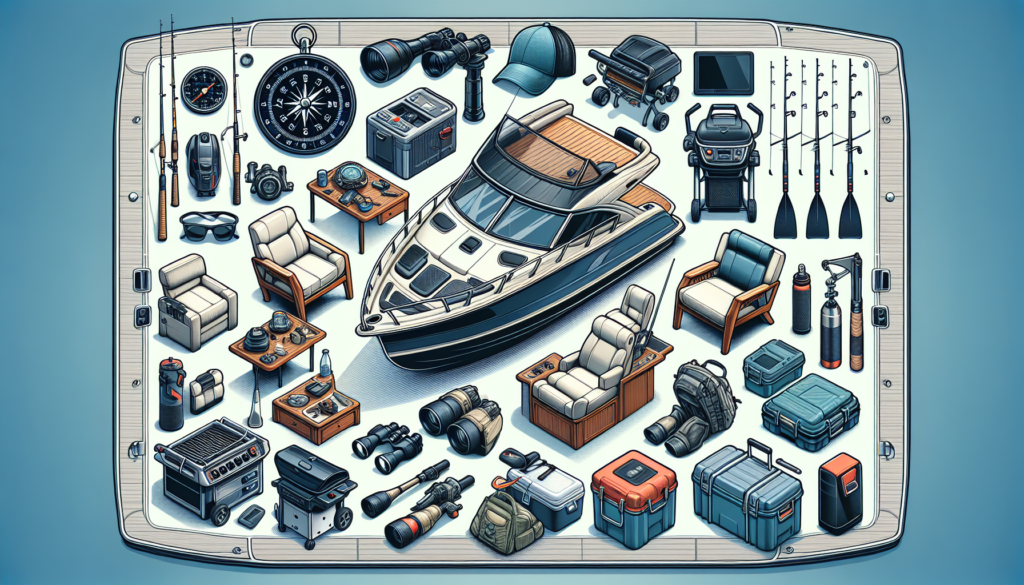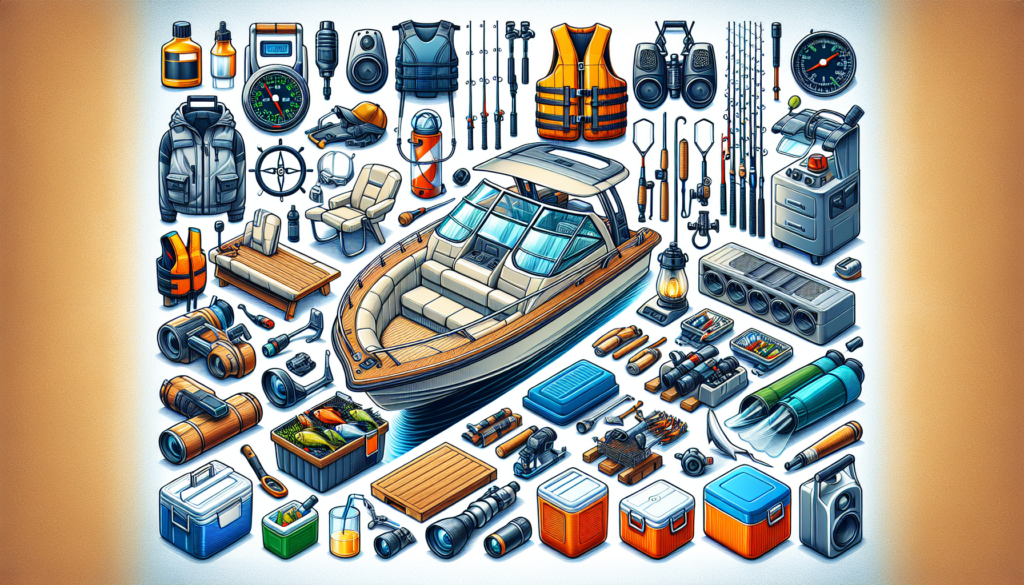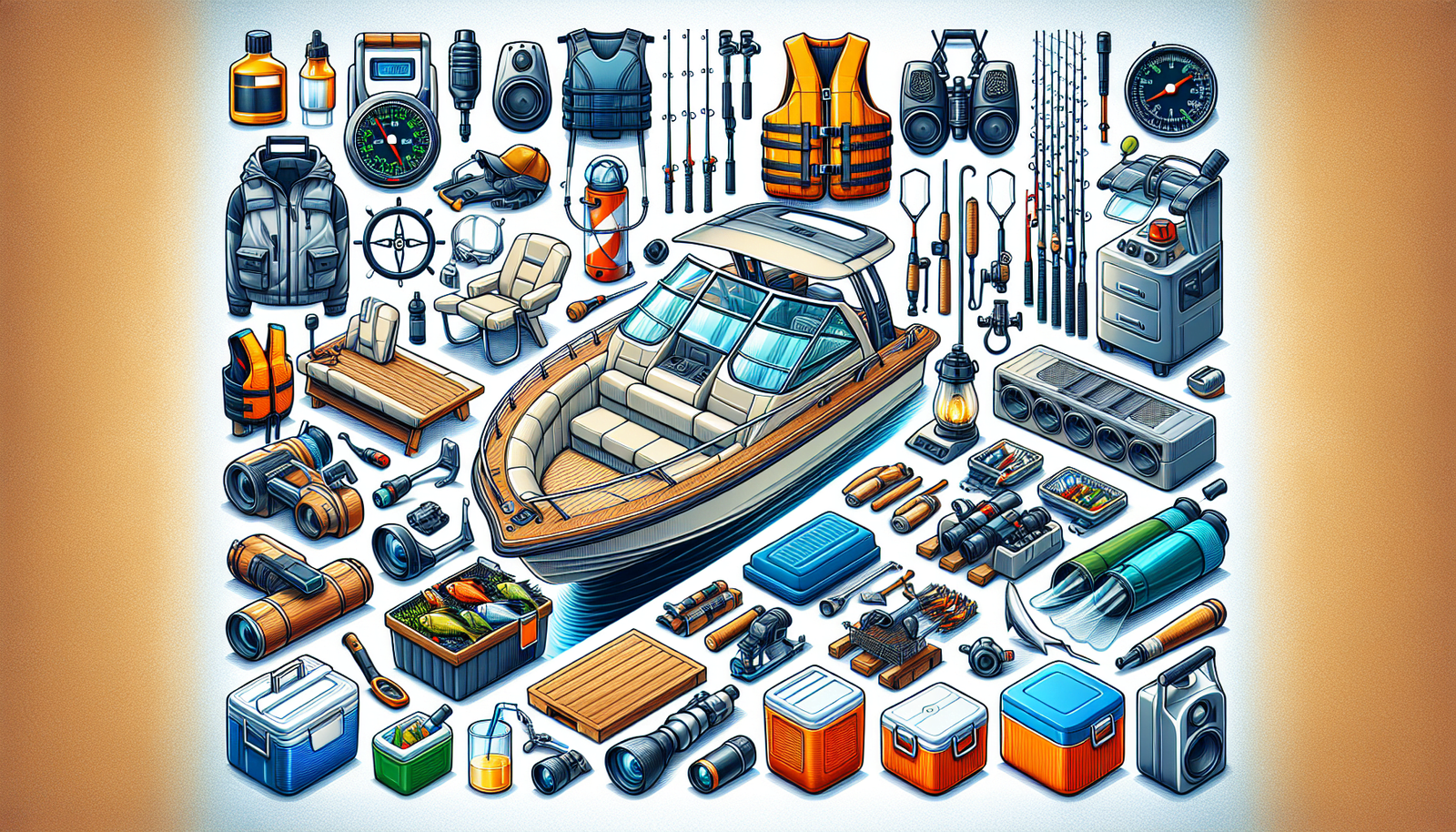Imagine stepping onto your boat, the sun glinting off the water, with not just the basics, but equipped with the best accessories that exponentially enhance your boating trip. This article is going to guide you through the top 10 essential accessories that can amplify your fun and safety during those laid-back recreational boating sessions. Grab your boat keys as we set the sails to a more enjoyable and smooth-sailing experience.
Personal Floatation Devices (PFDs)
When it comes to boating, your safety should be the topmost priority. Among other safety gear, Personal Floatation Devices (PFDs), also known as life jackets, are crucial for any recreational boating experience.
Types of PFDs
There are different types of PFDs, each designed for a specific use or condition. Some PFDs are meant for calm, inland water where there’s a good chance of quick rescue. Others are designed for rough waters where rescue may take a little longer. Some are even designed specifically for water sports like kayaking or wakeboarding.
Coast Guard regulations
According to the United States Coast Guard regulations, all recreational boats must carry one wearable PFD for each person aboard. Moreover, boats 16ft and longer are required to carry throwable PFDs. Always make sure that your PFD is Coast Guard approved and suitable for your type of boating activity.
Comfort versus safety in PFDs
While comfort is an essential factor when selecting a PFD, it should never be at the expense of safety. A comfortable but ill-fitting PFD might provide a false sense of security. Always ensure your PFD fits snugly, but not tightly. Try it on before purchasing and ensure it’s the appropriate size for your weight and chest size.
Children and PFDs
For kids, special care should be taken while selecting PFDs. Choose a child-size life jacket with a strap that goes between the legs and a headrest to keep the child’s head above water. Never use inflatable toys as a replacement for a PFD.
Boating Safety Kit
Before hitting the open water, it’s important to have a comprehensive boating safety kit on board.
First-aid supplies
Your boating safety kit should include a well-stocked first aid box with bandages, antiseptics, pain relievers and any prescribed medications.
Fire extinguisher
A fire extinguisher is a must-have in every boating safety kit. Replace or service them as per manufacturer’s instructions so they remain in good working condition.
Distress signals
Distress signals like flares, air horns or a whistle can capture attention in case of an emergency. Make sure to familiarize yourself with how to use these signals before you set sail.
Anchor with a line
An anchor with a line is an essential part of the safety gear. It can help you hold your boat in place during a breakdown or prevent it from drifting away in strong currents or windy conditions.

Navigation Equipment
When you’re out on the water, the right navigation equipment can make all the difference.
GPS system
GPS systems are the modern heroes of sea navigation. They can help you find your location, keep track of your route and even point out nearby harbours or marinas.
Compass
Even in the world of advanced electronic devices, a traditional compass still holds its value. It’s a reliable backup if your electronic navigational equipment fails.
Maps and charts
Carrying physical maps and charts of the area you’re navigating is essential. They not only provide a detailed view of the seafloor and shorelines but also the locations of channels, sandbars and other potential hazards.
Depth sounder
A depth sounder, or echosounder, can help you detect underwater objects and the seabed’s depth beneath your boat. It’s a useful tool to avoid running aground or colliding with underwater objects.
Vessel Lights
Proper vessel lights are crucial to ensure visibility and safety during your boating trips.
Regulations on lights
Right lighting not only assists in safe navigation but it’s also legally required after sunset. Be sure you’re familiar with the regulations regarding sail lights, stern lights, and masthead lights as in some areas, non-compliance might lead to penalties.
Different types of lights
Diverse types of lights serve different purposes on a boat. Running lights help other boats see you, anchor lights indicate your boat is anchored, and cabin lights help you see inside your boat at night.
Power sources for lights
Vessel lights are usually powered by the boat’s electrical system. However, it’s a good idea to have a set of battery-operated backup lights in case of any power failure.

Communication Devices
Communication devices are an essential part of your boating accessories, helping you stay connected and well-informed.
VHF radio
VHF radio is vital for marine communication. It’s used for contacting harbour staff, communicating with other boats, and most importantly, calling for help during emergencies.
Cellular phone
While cell phone coverage might be spotty or non-existent in some parts of the ocean, having a cell phone can be helpful, especially near the shore or in waters with good reception.
Satellite phone
For areas with no cellular coverage, satellite phones can be a lifeline, helping you stay connected even in the middle of the ocean.
Emergency Position Indicating Radiobeacon
An Emergency Position Indicating Radiobeacon (EPIRB) is a device that sends a distress signal and your location to the nearest rescue agency in case of an emergency, making it a valuable investment for any boater.
Boat Anchors
Your boat anchor is one of the most significant accessories for a recreational boating experience.
Different types of anchors
There are several types of boat anchors available–fluke anchors, plow anchors, mushroom anchors and more. Each type is suited to a different bottom condition like muddy, sandy or rocky.
Anchor line or rope
The rope or line attached to your anchor, known as rode, should be sturdy and long enough to hold your boat securely.
Anchor chain
The anchor chain, attached between the anchor and line, helps anchor the boat more securely by lying on the seabed and reducing the anchor’s angle.
Anchor selection based on boat size
Your boat’s size and weight play a crucial role in selecting the appropriate anchor. A small anchor might not hold your boat steady, whereas an excessively large one could be difficult to handle.
Coolers
During a sunny day on the water, coolers are a must-have to keep your drinks and food fresh.
Sizes and types of coolers
Select a cooler that fits your space and needs. Soft-sided coolers are great for short trips, while hard coolers are perfect for longer voyages.
Keeping food and drinks cold
To keep your food and drinks cold for a longer period, pre-chill your cooler before adding ice. Use larger ice blocks rather than small cubes to extend melting time.
Portable ice makers for boats
Consider investing in a portable ice maker for boats. It can produce ice on demand, ensuring a steady supply of icy-cold drinks during your day at sea.
Weather Gear
Proper weather gear is important to protect you from harsh boating conditions.
Waterproof clothing
A good quality waterproof jacket or pants can keep you dry and comfortable during rainy weather.
Wide-brimmed hats
A wide-brimmed hat shields your face and neck from sunburn while getting a dose of vitamin D.
Sunscreen
Use of sunscreen should be a no-brainer to protect your skin from harmful UV rays, even on cloudy days.
Sunglasses
Invest in a good pair of polarized sunglasses. Besides protecting your eyes from the sun, they can also reduce glare and reflection, improving visibility.
Deck Shoes
Choosing the right footwear is key for a comfortable and safe boating experience.
Different types of deck shoes
There are numerous types of deck shoes available. Some feature non-marking soles, some have quick-drying materials, and others are made to keep feet warm in colder conditions.
Ensuring proper fit
Just like any other shoe, a proper fit is crucial. Deck shoes should be comfortable and snug, but not too tight.
Materials of deck shoes
Deck shoes typically feature leather or synthetic materials that offer resistance to water and salt, and provide excellent grip on slippery decks.
Water resistance
Opt for water-resistant or quick-drying deck shoes. These will ensure your feet stay dry and comfortable all day long.
Proper Seating
Comfortable seating is another essential aspect of a pleasurable boating experience.
Types of on-deck seating
From fold-down seats and cushioned benches to swivel seats and pedestal seats, a variety of on-deck seating options are available to suit your boat’s layout and your comfort preference.
Ensuring comfort through proper seating
Having comfortable seating that puts less strain on your body during prolonged periods is essential. Choose seating with enough padding and ergonomic design, which can significantly enhance your comfort level.
Accessories for deck seating
Additionally, incorporating seating accessories like cushions, seat covers, or adjustable footrests can greatly improve your comfort and seating experience.
Boating is not just about getting from point A to point B. It’s about enjoying the journey, and with these essential accessories handy, you can ensure a safe and pleasurable boating experience.

